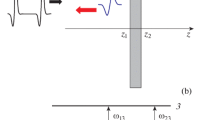Abstract
Conventionally, attosecond pulses are obtained using generation of high-order optical harmonics upon excitation of various media by femtosecond laser pulses with the central frequency in the infrared range. Here, we consider theoretically an alternative possibility of obtaining an isolated extreme ultraviolet (XUV) attosecond pulse in a thin layer of helium atoms excited by a pair of half-cycle (quasi-unipolar) X-ray pulses. The approach is based on the free polarization decay of an atomic medium. An analogy of the processes under consideration with the phenomenon of superradiance is discussed.




Similar content being viewed by others
REFERENCES
P. B. Corkum and F. Krausz, Nat. Phys. 3, 381 (2007).
F. Krausz and M. Ivanov, Rev. Mod. Phys. 81, 163 (2009).
F. Calegari et al., J. Phys. B: At., Mol. Opt. Phys. 49, 062001 (2016).
V. V. Strelkov, V. T. Platonenko, A. F. Sterzhantov, and M. Yu. Ryabikin, Phys. Usp. 59, 425 (2016).
K. Ramasesha, S. R. Leone, and D. M. Neumark, Ann. Rev. Phys. Chem. 67, 41 (2016).
M. T. Hassan, T. T. Luu, A. Moulet, O. Raskazovskaya, et al., Nature (London, U.K.). 530, 66 (2016).
M. Nisoli, P. Decleva, F. Calegari, A. Palacios, and F. Martin, Chem. Rev. 117, 10760 (2017).
P. B. Corkum, Phys. Rev. Lett. 71, 1994 (1993).
I. J. Sola, E. Mevel, L. Elouga, E. Constant, V. Strel-kov, et al., Nat. Phys. 2, 319 (2006).
G. Chen, E. Cunningham, and Z. Chang, J. Mod. Opt. 64, 952 (2017).
H. Tai, F. Li, and Z. Wang, J. Mod. Opt. 63, 1166 (2016).
J. Mauritsson, P. Johnsson, E. Gustafsson, A. L’Huillier, K. J. Schafer, and M. B. Gaarde, Phys. Rev. Lett. 97, 013001 (2006).
Z. Tibai, G. Tóth, M. I. Mechler, J. A. Fülöp, G. Almási, and J. Hebling, Phys. Rev. Lett. 113, 104801 (2014).
H. A. Navid, R. Aghbolaghi, and Z. Yarali, J. Mod. Opt. 66, 1744 (2019).
H. C. Wu and J. Meyer-ter-Vehn, Nat. Photon. 6, 304 (2012).
J. Xu, B. Shen, X. Zhang, et al., Sci. Rep. 8, 2669 (2018).
M. V. Arkhipov, R. M. Arkhipov, A. V. Pakhomov, I. V. Babushkin, A. Demircan, U. Morgner, and N. N. Rosanov, Opt. Lett. 42, 2189 (2017).
A. V. Pakhomov, R. M. Arkhipov, M. V. Arkhipov, I. Babushkin, and N. N. Rosanov, Opt. Spectrosc. 123, 913 (2017).
R. M. Arkhipov, M. V. Arkhipov, P. A. Belov, Yu. A. Tolmachev, and I. Babushkin, Laser Phys. Lett. 13, 046001 (2016).
A. V. Pakhomov, R. M. Arkhipov, I. V. Babushkin, M. V. Arkhipov, Yu. A. Tolmachev, and N. N. Rosanov, Phys. Rev. A 95, 013804 (2017).
R. M. Arkhipov, A. V. Pakhomov, I. Babushkin, Yu. A. Tolmachev, and N. N. Rosanov, JETP Lett. 105, 408 (2017).
A. V. Pakhomov, R. M. Arkhipov, M. V. Arkhipov, A. Demircan, U. Morgner, and N. N. Rosanov, Sci. Rep. 9, 7444 (2019).
R. M. Arkhipov, A. V. Pakhomov, M. V. Arkhipov, A. Demircan, U. Morgner, N. N. Rosanov, and I. Babushkin, Phys. Rev. A (in press); arXiv:1907.11488.
L. Allen and J. H. Eberly, Optical Resonance and Two-Level Atoms (Wiley, New York, 1975).
N. Ishii, K. Kaneshima, K. Kitano, T. Kanai, S. Watanabe, and J. Itatani, Nat. Commun. 5, 3331 (2014).
M. Chini, K. Zhao, and Z. Chang, Nat. Photon. 8, 178 (2014).
Z. Chang, P. B. Corkum, and S. R. Leone, J. Opt. Soc. Am. B 33, 1081 (2016).
E. G. Bessonov, Sov. Phys. JETP 53, 433 (1981).
E. G. Bessonov, Sov. J. Quant. Electron. 22, 27 (1992).
R. M. Arkhipov, M. V. Arkhipov, I. Babushkin, A. Demircan, U. Morgner, and N. N. Rosanov, Opt. Lett. 44, 1202 (2019).
R. M. Arkhipov, M. V. Arkhipov, A. V. Pakhomov, and N. N. Rosanov, Opt. Spectrosc. 128, 102 (2020).
N. N. Rosanov and N. V. Vysotina, J. Exp. Theor. Phys. 130, 52 (2020).
R. M. Arkhipov, M. V. Arkhipov, A. A. Shimko, A. V. Pakhomov, and N. N. Rosanov, JETP Lett. 110, 15 (2019).
A. Yariv, Quantum Electronics (Wiley, Chichester, 1989; Sov. Radio, Moscow, 1980).
S. A. Akhmanov and S. Y. Nikitin, Physical Optics (Clarendon, Oxford, 1997; Nauka, Moscow, 2004).
M. Born and E. Wolf, Principles of Optics: Electromagnetic Theory of Propagation, Interference and Diffraction of Light (Elsevier, 2013).
I. I. Sobel’man, Introduction to the Theory of Atomic Spectra (Nauka, Moscow, 1977; Pergamon, Oxford, 1972).
S. E. Frish, Optical Spectra of Atoms (Fizmatlit, Moscow, Leningrad, 1963) [in Russian].
V. L. Ginzburg, Sov. Phys. Usp. 26, 713 (1983).
W. D. Zhang, E. R. Brown, A. Mingardi, R. P. Mirin, N. Jahed, and D. Saeedkia, Appl. Sci. 9, 3014 (2019).
Funding
Investigations by R.M. Arkhipov and N.N. Rosanov were financially supported by the Russian Foundation for Basic Research, project nos. 20-32-70049 (theory of attosecond pulse generation and numerical simulations) and 19-02-00312 (sections devoted to the simplified classical theory for the generation of an attosecond pulse and the connection with superradiance). I. Babushkin acknowledges support from the PhoenixD innovation cluster (EXC 2122, project no. 390833453) and Deutsche Forschungsgemeinschaft, project no. BA4156/4-2.
Author information
Authors and Affiliations
Corresponding author
Ethics declarations
The authors declare that they have no conflict of interest.
Rights and permissions
About this article
Cite this article
Arkhipov, R.M., Arkhipov, M.V., Babushkin, I. et al. Generation of an Attosecond Pulse in Helium Excited by Half-Cycle X-Ray Pulses. Opt. Spectrosc. 128, 529–535 (2020). https://doi.org/10.1134/S0030400X20040025
Received:
Revised:
Accepted:
Published:
Issue Date:
DOI: https://doi.org/10.1134/S0030400X20040025




